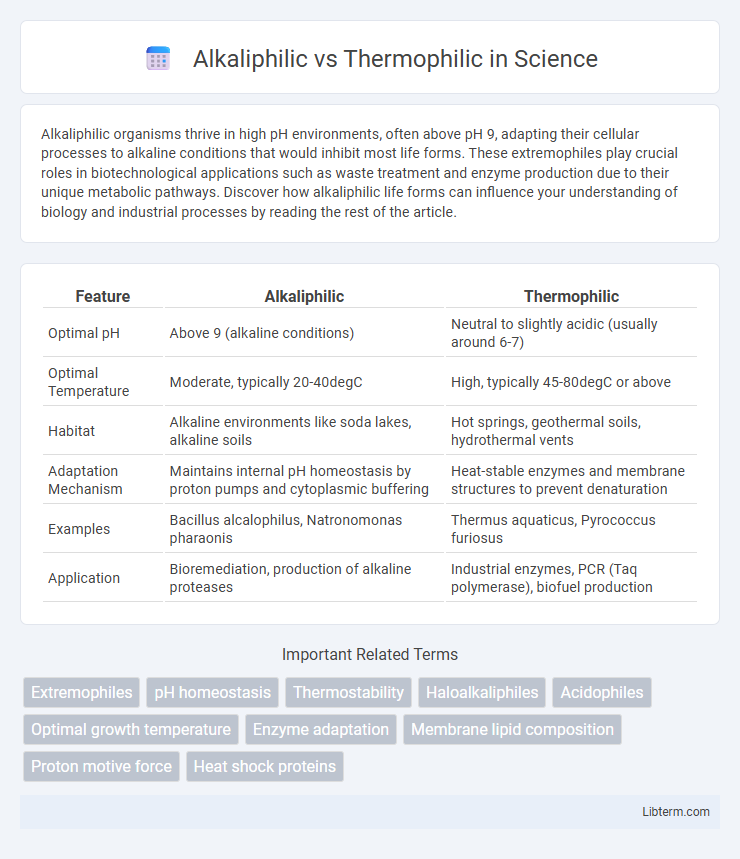Alkaliphilic organisms thrive in high pH environments, often above pH 9, adapting their cellular processes to alkaline conditions that would inhibit most life forms. These extremophiles play crucial roles in biotechnological applications such as waste treatment and enzyme production due to their unique metabolic pathways. Discover how alkaliphilic life forms can influence your understanding of biology and industrial processes by reading the rest of the article.
Table of Comparison
| Feature | Alkaliphilic | Thermophilic |
|---|---|---|
| Optimal pH | Above 9 (alkaline conditions) | Neutral to slightly acidic (usually around 6-7) |
| Optimal Temperature | Moderate, typically 20-40degC | High, typically 45-80degC or above |
| Habitat | Alkaline environments like soda lakes, alkaline soils | Hot springs, geothermal soils, hydrothermal vents |
| Adaptation Mechanism | Maintains internal pH homeostasis by proton pumps and cytoplasmic buffering | Heat-stable enzymes and membrane structures to prevent denaturation |
| Examples | Bacillus alcalophilus, Natronomonas pharaonis | Thermus aquaticus, Pyrococcus furiosus |
| Application | Bioremediation, production of alkaline proteases | Industrial enzymes, PCR (Taq polymerase), biofuel production |
Introduction to Extremophiles
Extremophiles are microorganisms adapted to survive in environments with extreme conditions, such as high pH or temperature. Alkaliphilic extremophiles specifically thrive in alkaline environments with a pH above 9, while thermophilic extremophiles grow optimally at temperatures between 45degC and 80degC. These adaptations enable them to perform essential biochemical processes under conditions lethal to most life forms.
Defining Alkaliphilic and Thermophilic Microorganisms
Alkaliphilic microorganisms thrive in environments with high pH values, typically above 9, showcasing adaptations that enable survival and metabolic activity under extreme alkaline conditions. Thermophilic microorganisms prefer elevated temperatures, generally between 41degC and 122degC, with cellular mechanisms optimized for stability and function in heat-rich habitats. These extremophiles contribute significantly to biotechnology, industrial processes, and ecological studies by exploiting their unique enzymatic properties.
Environmental Niches: Where They Thrive
Alkaliphilic organisms thrive in high pH environments such as soda lakes and alkaline soils, where pH levels typically exceed 9, enabling them to adapt to conditions hostile to most life forms. Thermophilic microorganisms inhabit extreme temperature niches, including hot springs, hydrothermal vents, and compost piles, with optimal growth temperatures ranging from 45degC to over 80degC. These specialized adaptations allow alkaliphilic and thermophilic microbes to occupy unique ecological roles critical for nutrient cycling in extreme habitats.
Cellular and Molecular Adaptations
Alkaliphilic microorganisms thrive in high pH environments by maintaining cytoplasmic pH homeostasis through specialized ion pumps and Na+/H+ antiporters that prevent alkaline damage to cellular components. Thermophilic organisms possess heat-stable enzymes with increased ionic interactions and hydrophobic cores, alongside chaperone proteins like heat shock proteins (HSPs) that facilitate proper protein folding under extreme temperatures. Both adaptations involve modifications in membrane lipid composition, such as ether-linked lipids in thermophiles and altered fatty acid saturation in alkaliphiles, enhancing membrane stability and function in extreme conditions.
Metabolic Strategies and Energy Production
Alkaliphilic microorganisms thrive in high pH environments by utilizing specialized proton motive force systems and sodium ion gradients to drive ATP synthesis, enabling efficient energy production under alkaline conditions. Thermophilic microbes employ heat-stable enzymes and increased membrane lipid saturation to maintain metabolic function and optimize energy conversion at elevated temperatures. Both adaptations reveal distinct metabolic pathways that enhance survival by maximizing ATP yield corresponding to their extreme environmental niches.
Industrial and Biotechnological Applications
Alkaliphilic microorganisms thrive in high pH environments and are utilized in the production of industrial enzymes such as alkaline proteases and cellulases, which are essential in detergents and biofuel production. Thermophilic microbes, capable of surviving at elevated temperatures, are crucial for processes like biomass conversion and waste treatment due to their thermostable enzymes that enhance reaction efficiencies under harsh industrial conditions. Combining alkaliphilic and thermophilic properties in engineered strains advances biotechnological applications by enabling robust, efficient enzymatic processes in extreme environments, improving industrial productivity and sustainability.
Comparative Genomics and Evolutionary Insights
Comparative genomics of alkaliphilic and thermophilic microorganisms reveals distinct genetic adaptations enabling survival in high pH versus high temperature environments, such as genes for alkaline-resistant enzymes and heat-stable proteins respectively. Evolutionary insights indicate convergent evolution of stress response mechanisms, including membrane modifications and chaperone systems, tailored to their extreme habitats. Genome analyses highlight horizontal gene transfer events that contribute to niche specialization and metabolic versatility in both extremophile groups.
Challenges in Laboratory Cultivation
Cultivating alkaliphilic microbes requires maintaining stable high-pH environments, often above pH 9, which can cause precipitation of essential nutrients and complicate growth medium formulation. Thermophilic microorganisms demand precise thermal control, generally between 50degC and 80degC, to mimic their natural habitats while preventing protein denaturation or thermal inactivation of enzymes. Both types of extremophiles present challenges in maintaining optimal growth parameters while ensuring the viability and reproducibility of cultures for experimental analysis.
Environmental and Ecological Impacts
Alkaliphilic microorganisms thrive in high pH environments, playing a crucial role in the biodegradation of organic matter in alkaline soils and soda lakes, thus influencing nutrient cycling and ecosystem stability. Thermophilic organisms, adapted to high-temperature habitats such as hot springs and hydrothermal vents, contribute to the breakdown of complex organic compounds, enhancing carbon turnover and supporting unique microbial communities. Both extremophiles drive biogeochemical processes that sustain diverse ecosystems under extreme conditions, impacting global nutrient fluxes and environmental resilience.
Future Research Directions and Emerging Trends
Future research in alkaliphilic and thermophilic microorganisms emphasizes genetic engineering to enhance enzyme stability and activity under extreme pH and temperature conditions. Emerging trends include biotechnological applications in industrial processes such as bioremediation, biofuel production, and pharmaceuticals, leveraging extremozymes for sustainable and efficient solutions. Metagenomic and proteomic approaches are expanding the discovery of novel extremophiles, facilitating innovative strategies for environmental and commercial exploitation.
Alkaliphilic Infographic

 libterm.com
libterm.com